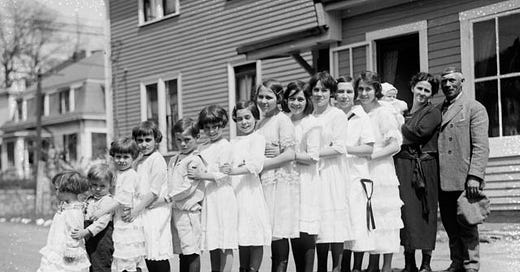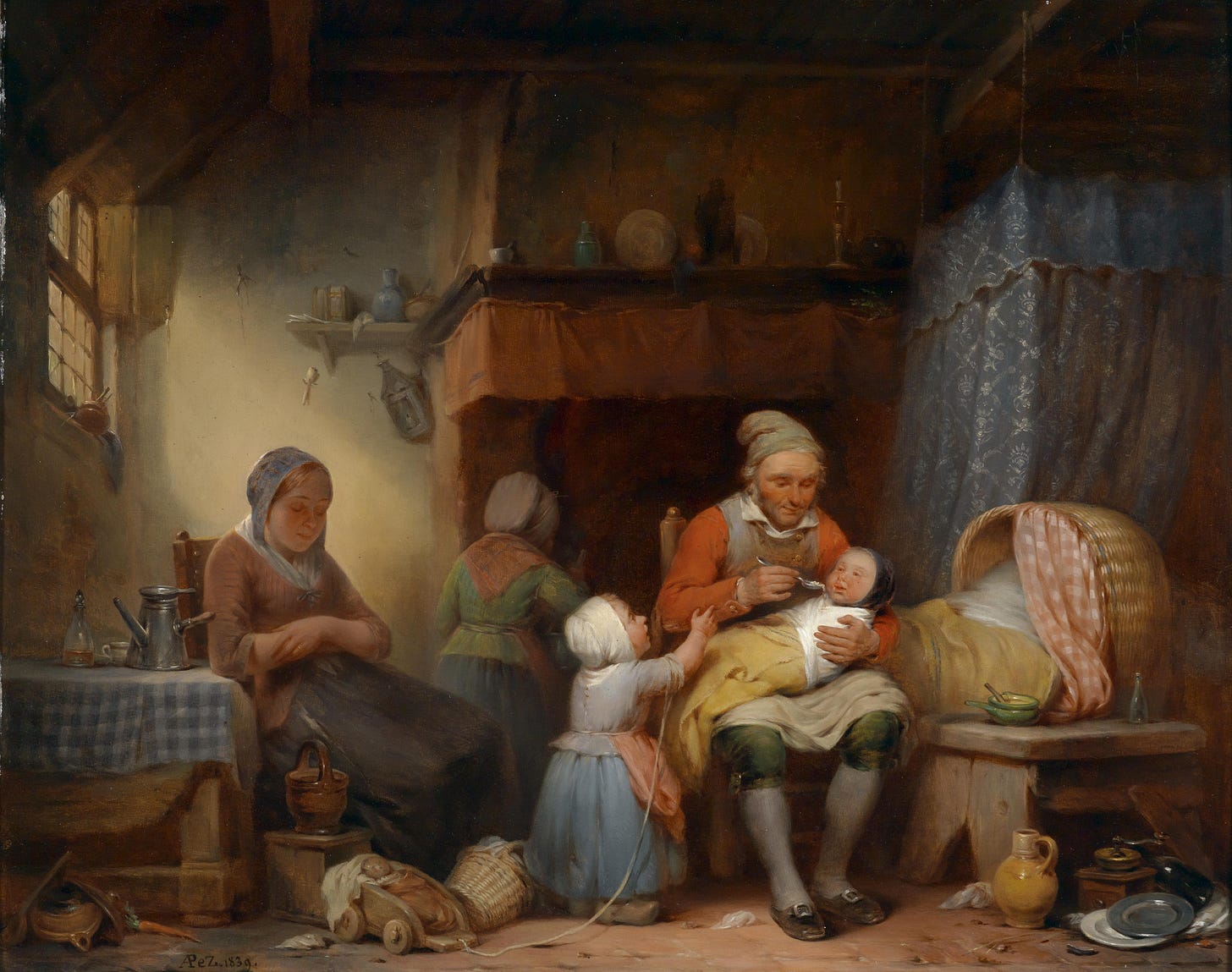The Math No One Dares Do: Canada's Birthrate Crisis Is Far Worse Than You Think
The statistical averages don’t even begin to reveal how demographics actually work or the true scale of the problem.
How We Normally Hear About Birthrates
Most Canadians have a vague sense that there’s a birthrate problem—low numbers, not enough babies, aging population, we must grow… something… GDP… for some reason—but the mental model we carry is still rooted in outdated fears of overpopulation.
For Boomers especially, raised during the era of The Population Bomb, the idea of having fewer children was seen as not just acceptable, but responsible. Smaller families meant saving the planet, easing the burden, living more lightly on the Earth. The poor boomers just keep imagining that population line going up.
As a modern counterpoint to that is a simple-seeming bit of demographic arithmetic: “Each couple needs two children to replace themselves.” Well, 2.1 actually, to allow some accounting for accidents, illness, and disease. It sounds logical. Symmetrical. Reassuring. Though we’re in the red zone, it gives the impression that if most people just have two kids, things will carry on just fine.
Key Observations:
No major Western country is currently at or above the replacement level of 2.1 children per woman.
France maintains the highest fertility rate among European Union countries, despite recent declines.
The United States has experienced a significant drop in fertility rates, reaching historic lows.
Canada's fertility rate has hit a record low, with similar trends observed in Germany, Spain, Italy, and Portugal.
Australia's fertility rate has also declined, reflecting broader trends in developed nations.
These figures underscore the demographic challenges facing Western countries, with potential implications for economic growth, social support systems, and long-term population sustainability.
But here’s the problem: These numbers don’t even begin to reveal how demographics actually work or the true scale of the problem.
Statistical averages mask structural concentrations.
If the average is 1.4 children per woman, but only half of women have children, then those who do must have nearly 3 each to hit that average. But we rarely hear that.
We never hear the practical math. We never talk about who’s actually having children, and how many. We rarely ask whether the households that are forming today are even capable—economically, structurally, culturally—of raising the next generation.
This essay does that math. And the numbers are not just shocking. They are civilization-defining. They overturn the assumptions at the core of our national planning, our politics, and our private lives. And they point to a singular conclusion:
If we don’t fix the household, we don’t fix anything.
Because without households that form, grow, and endure, there is no future to debate policy for.
The Canadian View
There is a quiet fiction at the heart of Canadian public life. You’ll find it lurking behind every policy on immigration, housing, education, and healthcare. It’s in every budget forecast, every pension plan, every long-range economic model. The fiction is this: that our population will continue.
It will not.
Or rather—it will not continue as things are. Because Canada’s birthrate crisis is not just a slow decline. It’s a demographic collapse in disguise. And once you do the math, the truth is more alarming than anyone in public life seems willing to admit.
Look at that line… things are good right?! Right?
Nope.
If we want to replace Canada's current population of 40 million people, and only 3.5 million households are raising kids, each of those households would need to produce nearly 12 children just to break even over time.
Big Ideas for Little Economies
Imagine if, instead of being taxed for working harder, you were rewarded for it.
The Missing Household Math
Most reporting on the topic uses a polite, bloodless phrase: "fertility rate." Canada's is currently just below 1.4 children per woman. Replacement rate is 2.1. We are, everyone agrees, below it. But the real issue is not the average—it’s the distribution.
Canada has roughly 15 million households. Of those, only 3.5 million are households with children living at home. That means only about 23% of households are doing the work of raising the next generation. The rest are single, childless couples, empty nesters, or other configurations. And it won’t surprise you to learn that the number of households with children is declining… uncontrollably.
If we want to replace Canada's current population of 40 million people, and only 3.5 million households are raising kids, each of those households would need to produce nearly 12 children just to break even over time.
That is not a typo. It is the math. That’s the real arithmetic burden placed on the small slice of society that is actually having and raising children today.
Even if you assume some of the other households will go on to raise children eventually, the burden still falls on an increasingly narrow base. The polite fiction of “every person just needs one child” collapses instantly when you realize how few people are actually having any at all.
We Talk About Fertility. But The Real Crisis Is Households.
The obsession with individual fertility rates has distracted us from the real structural problem: the collapse of the household as a basic economic and social unit. The sixties gave us a new way to understand this. The Chicago School’s "New Home Economics," led by Gary Becker and Jacob Mincer, began treating the household as the true unit of economic analysis.
Becker’s theory was that households, not just individuals, make decisions about labor, time, and investment. Raising a child is a capital-intensive endeavor. Households allocate resources, not just to earning money, but to cultivating future people—citizens, workers, caregivers.
But this insight never really took root in policy. Why? Because the conversation got hijacked.
The moment anyone tried to talk about households, the room split: debates about gender roles, patriarchy, unpaid labor, feminism. Instead of asking how we support the human project of creating and sustaining households, we got lost in an ideological food fight about who should do the dishes.
Meanwhile, the household itself was quietly collapsing.
Immigration Is Not a Solution—It is, at best, a Delay
Immigration is the only thing keeping Canada's population curve from pointing straight down. And so we import people. More and more each year. But immigrants age. And immigrants, once here, tend to adopt the same low-fertility behaviors as native-born Canadians.
So unless immigrants themselves form households and have children above the replacement rate, immigration only delays the collapse. It does not stop it no matter how many immigrants come.
And it raises a morally urgent question: is Canada building a society worth reproducing? Or are we simply luring people into a machine that chews up youth, productivity, and community, and spits out isolated, aging taxpayers with no support and no stake?
The Ship of Theseus
The Ship of Theseus is a thought experiment from ancient Greece. In Nova Scotia, we might well call it the Bluenose Experiment.
Imagine a great wooden ship, honored and preserved for generations. Over time, its planks rot and are replaced—one by one—until no original piece remains. Is it still the same ship?
Now imagine that someone gathers the discarded, original planks and rebuilds the old ship elsewhere. Which is the true Ship of Theseus?
This story forces us to ask: what makes something itself—its material parts or its identity?
Applied to a nation, the question becomes uncomfortable. If every custom, language, value, and citizen is slowly replaced, what remains of the country itself? Is it still Canada? Or is it just a shape with the same name, floating unmoored in history?
Canada and the Ship of Theseus
The Ship of Theseus is a classic philosophical paradox. If you gradually replace every plank of a ship, at what point is it no longer the original ship? If none of the original materials remain—but the form is preserved—is it still the same thing?
Apply that to Canada:
If the founding population has below-replacement fertility…
And if immigration becomes the sole engine of population and cultural growth…
And if new arrivals bring with them entirely different traditions, languages, histories, values, and assumptions…
What remains “Canadian” about Canada?
Multiculturalism or Multipolarism?
When multiculturalism was first introduced as policy, the idea was to welcome newcomers while preserving a shared Canadian identity—a common civic framework into which people from diverse backgrounds could integrate. The metaphor was often a mosaic rather than a melting pot, but it still presumed a frame, a unifying national concept.
But over time, that frame weakened. The institutions stopped expecting integration. Instead, they celebrated difference for its own sake, and even began to view traditional Canadian values—liberal democracy, pluralism, rule of law, free speech, civic duty, Anglo-French heritage—as outdated or oppressive.
So multiculturalism, once meant to enrich a coherent national identity, began to dissolve it.
What we now have might be more accurately called multipolarism: a country with many coexisting but unintegrated micro-nations, cultures, and value systems, many of which share little with the founding principles or each other. It is peaceful for now, but it is not stable. It has no shared why.
What Is There to Care About?
This leads to a deeper and more disturbing question:
If Canada becomes an anonymous zone for resource extraction, tax collection, and international transit—rather than a coherent civilization—why should any Canadian feel loyalty to it?
If there is no shared:
Language of meaning
Memory of struggle
Vision of purpose
Bond of duty
Then the country ceases to be a home and becomes simply a location. A launchpad for personal ambition. A brand. A hotel with citizenship papers.
And if that’s all it is, then—the question “Why care about Canada’s future?” becomes difficult to answer. Because the very idea of Canada becomes impossible to define.
We’ve Confused the Symbol for the thing Symbolized
We confused the structure for the purpose. We let ideology devour anthropology. And we forgot a simple truth: people need people. A household—however it’s arranged—gives us continuity, duty, and daily purpose. It ties us to the past and to the future. It reminds us that life isn’t lived on the timeline of quarterly earnings or trending hashtags—it’s lived in the slow rituals of shared meals, weathered winters, sick days, birthdays, forgiveness, and care.
Now, generations of post-household living, we are reaping the whirlwind.
Men, once shamed for being breadwinners, now wander disconnected and purposeless.
Women, sold the myth of having it all, are burned out from doing it all.
Children are increasingly raised by institutions, not kin. They openly imagine a future that is less than the past.
Elders sit alone in care homes, kept alive but unmoored from legacy or love.
And in every demographic—rich and poor, young and old, right and left—we find rising rates of loneliness, isolation, anxiety, and despair.
Not because we lack money.
Not because we lack rights.
But because we lack households—that ancient human arrangement that gave all of us, regardless of our role, a place to belong, to serve, to grow.
Maybe it’s time to stop arguing about who does the dishes, and start rebuilding the kitchen.
Maybe it’s time to stop designing policies around individuals, and start designing for households.
Maybe it’s time to remember what we already knew for thousands of years:
A nation is only as strong as its households. And our households are in ruins.
Is There a Fix?
There’s a way forward, but it’s not politically easy:
We must restore the household as the generative unit of culture and nationhood.
We must rediscover Canadian civic values—not as slogans, but as shared expectations for how to live together.
We must welcome immigrants—not as isolated demographics or solutions to our problems, but as future Canadians, encouraged and supported in joining a shared project.
And we must stop being afraid to say: if nothing binds us but paperwork and rent payments, then we don’t really have a country.
Canada can survive as a diverse country. But not as a directionless one.
In An Abandoned Household, The Rain Falls Equally on Us All
This isn’t just about women. Or men. Or policy. It’s about all of us.
Men without purpose, drifting.
Women exhausted by trying to do it all.
Children raised by strangers or screens.
Elders warehoused and forgotten.
The collapse of the household means the collapse of care, identity, duty, and purpose. It is a social catastrophe wearing the mask of choice.
And here’s the worst part: we’ve normalized it. We tell people it’s fine. That single life is freedom. That childlessness is empowerment. That living alone is modern. That rootlessness is progress. And then we wonder why anxiety, loneliness, and despair are epidemic.
A New Foundation
Let’s sit down before the facts with an open mind. We have to be prepared to give up every modern ideological and social justice notion. we have to follow humbly wherever and to whatever abyss Nature leads or we will learn nothing. We can’t trumpet ideas and ideology when facts are going in the opposite direction.
If we are to have a future—not just a GDP chart or a bond yield, but a living, human, multigenerational society—we must rediscover the household. Not as a 1950s sitcom rerun. Not as a gender role battlefield. But as the elemental unit of civilization.
A household is where people care for each other. Where the very young and the very old have meaning. Where the middle lives for more than self.
It doesn’t have to look one way. It doesn’t have to match a template. But it does have to exist.
Without households, we don’t just lose our population. We lose Canada.












A related perspective...did you see "60 Minutes" last weekend on what Japan is experiencing when it comes to their shrinking population problem. Equally thought-provoking: https://www.cbsnews.com/news/japan-population-decline-60-minutes/
There is one significant root problem the entire planet has (in that almost all of our problems can be traced back to it, or largely resolved by mitigating it) and that is overpopulation. What the worlds needs is stability, not growth. Sure, we can selfishly pick one country over another and say, Canada has a shrinking population which "hurts" us, while not talking about the balance where other parts of the world have way too much growth. We all live on one planet, and we need to think globally. Nothing good will come of the global population expanding on it's current trajectory. We all need to work together to bring the world back to balance. There is an interesting book called "The Lives of A Cell" which compares human population growth to cancer. it is quite enlightening when you see that pattern.